In the face of growing concerns over climate change and rising sea levels, science and tech continues to search for alternative viable homes for the human race.
But what possibilities are left for us here on Earth? Recent reports suggest that we could be living underwater in just 100 years’ time, with sea levels set to rise by up to metre by 2100.
With this in mind, in-home experts at Hillarys have investigated what our homes might look under the sea.
Why would we go underwater?
As both sea levels and population numbers continue to rise, we are increasingly faced with the prospect of resettling human colonies in other places.
While major tech giants like Space X are looking out as far as Mars, there is a reasonable argument to suggest that our own planet may still be able to offer refuge under our own vast oceans.
In fact, most scientific thinking argues that the deep blue would still be more habitable than nearby planets like Mars. Plus, all of the technology needed to begin building small colonies underwater already exists.

What’s it like to live underwater?
Conditions underwater would undoubtedly be tough, and it’s probably worth remembering that to date, it’s said that we’ve only explored around 5% of our ocean. However, there is plenty of evidence to suggest that human life could still survive here.
Currently, the best example of a successful underwater habitat is the Aquarius Reef Base, a dedicated underwater laboratory for the study of marine biology. The base can accommodate up to four people for several weeks at a time while they perform observations and other research, living and working beneath the depths.
Using the structure and technology harnessed by Aquarius, in-home experts at Hillarys have created an insight into how everyday homes might look and function under the sea.
What would our homes look like?
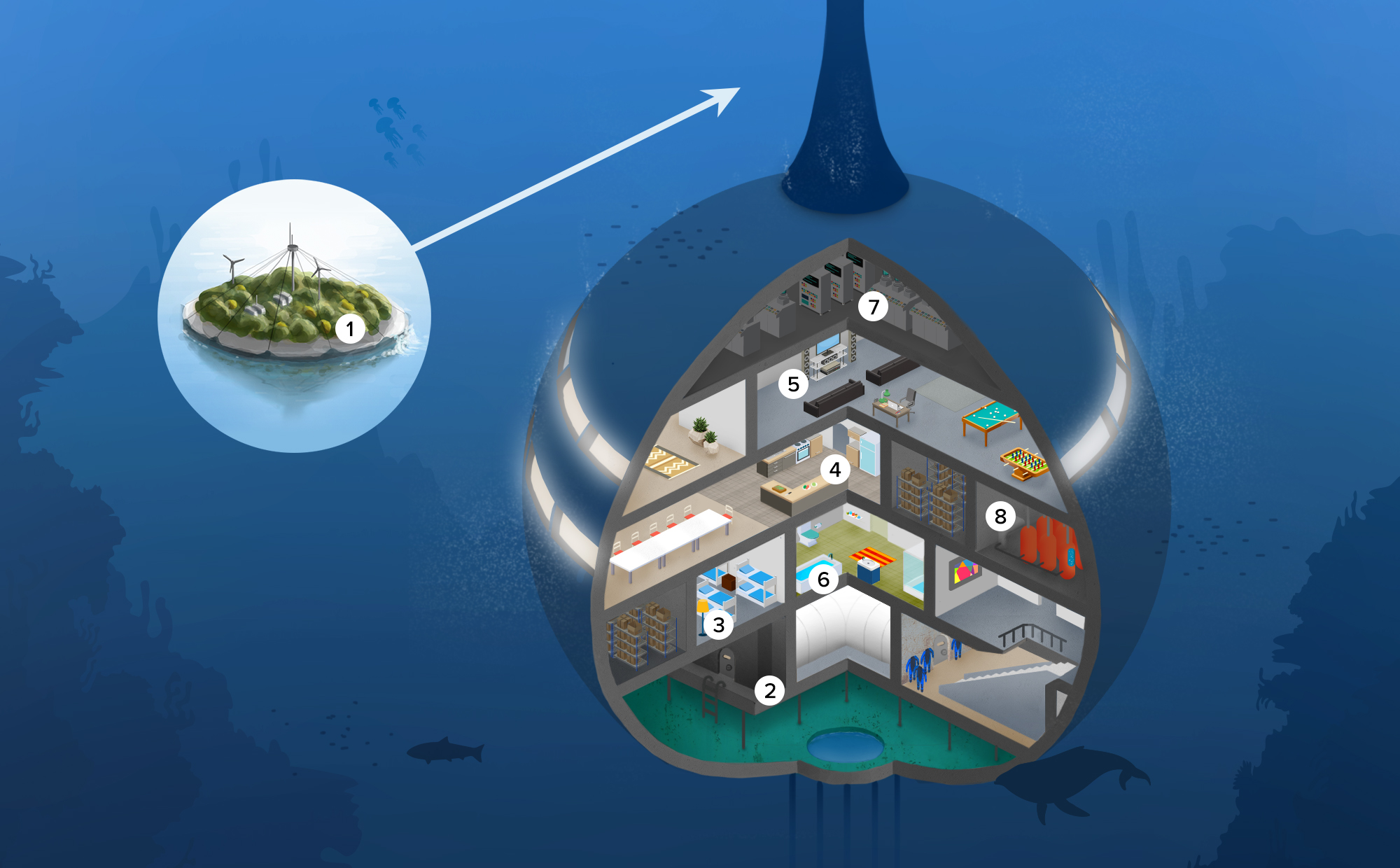
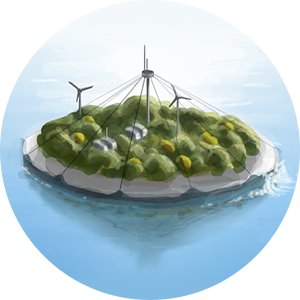
1. Life support buoy
The Aquarius Reef base is connected to a life support buoy on the surface, which
holds back up compressors and generators for an emergency, and supplies the base with an air
supply and internet and phone connections.
Houses built underwater would need something
similar, possibly with solar panels and wind turbines fitted to provide power. Plus, it’s
possible you could use some of the space to grow a few hardy crops too.
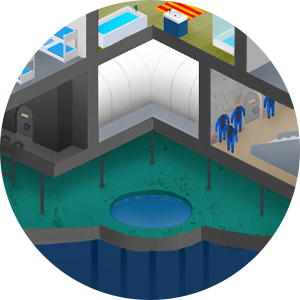
2. Wet porch and entry lock
Entering and exiting the house would be done through a ‘wet porch’. Here, the house
would be open to the ocean through a ‘moon pool’, where you could pop in and out much like a
swimming pool. The pressure inside the wet porch would remain at the same pressure as the water,
thus holding the water back and preventing flooding.
The rest of the house would be
pressurised to somewhere between the water pressure and surface pressure. Between the main house
and the wet porch, a small ‘entry lock’ would serve as a waiting area, where you would wait for
the pressure to match either the main house or the wet porch before you moved.
This would
also be where you’d keep your wetsuit and diving gear, ready for when you want to go out.
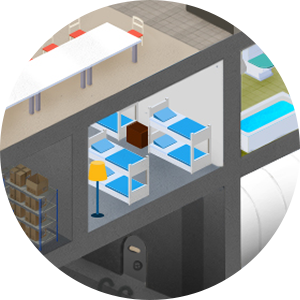
3. Bedroom
Living quarters would be much smaller and compact due to the need to maintain
pressurisation, so your bedroom would be a fairly snug space! Think bunk beds and lots of clever
storage solutions.
Some strategically placed windows could help make the room feel bigger
– just imagine counting fish as you drift off to sleep!

4. Kitchen
Most of your diet would consist of fresh fish (obviously), and crops grown on the
surface. This would more than likely be supplemented with a stash of dehydrated food, and fresh
water would be created by filtering sea water.
Due to the pressurisation, cooking would
have to be done without an open flame, so you’d probably need to rely on electric appliances to
do your cooking.
However, living underwater can substantially reduce your sense of taste,
so you might want to pack plenty of spices and seasonings to help – aquanauts reportedly pour
hot chilli sauce over every meal!

5. Living room and entertainment space
The connection to the life support buoy would mean that you could still receive
phone signal and an internet connection while underwater, so browsing social media, playing
computer games and binge-watching your favourite Netflix series’ would still be
possible.
It also means you can still call your mum or Skype your mates as normal. But be
warned, unless they’re also living underwater they may not recognise your voice, as the
pressurised environment makes you sound much higher! Luckily, this isn’t noticeable to those
living at the same pressure as you.

6. Bathroom
The biggest challenge of living underwater would be how to store and safely dispose of human waste. One possible solution could be to equip each house with a septic tank to store and break down waste. This could then be used to produce biogas or as fertiliser for crops growing on the life support buoy above.

7. Power room
Living underwater provides a variety of means for getting power, including ocean
thermal energy conversion or wind turbines and solar panels fitted on the life support
buoy.
Homes could then have a battery pack, such as the Tesla Powerwall, installed to
save any excess energy produced to be used at times when energy production is lower – like night
time or cloudier days.
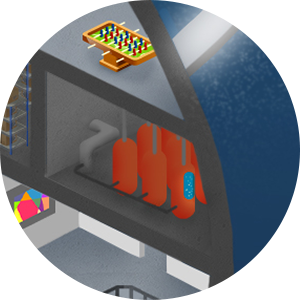
8. Life support control centre
Each home would need to be carefully monitored 24/7, as any technical fault or structural issue could be deadly. Much like the Aquarius Reef base, things like pressure, temperature and air supply would be controlled by a combination of computer systems and trained engineers.
Other things to consider
Even in airtight spaces, humidity levels in underwater habitats remain at around 70-100%. This means it exceptionally difficult to keep anything dry, and – when combined with the pressurisation – makes your body more prone to infections.
This means you’d need to make an extra effort to look after your health, and take care of any cuts, scrapes or other injuries. This could prove tricky as you’d be permanently a little ‘sea drunk’, thanks to the high levels of nitrogen in your blood from living at pressure. This dissolved into your bloodstream, producing laughing gas.
Simply popping back up to the surface for medical attention, emergency supplies or repair work to the life support buoy wouldn’t be easy. Instead, you’d have to wait more than 12 hours for your entire house to slowly reach surface pressure before you could come back up to avoid decompression sickness – known as ‘the bends’ – sometimes suffered by divers.

Take our survey
If you could, would you move to an underwater home?
If you could, would you move to an underwater home?
Thanks for submitting your answer.
Yes, absolutely!
I’m still not sure.
No way!

